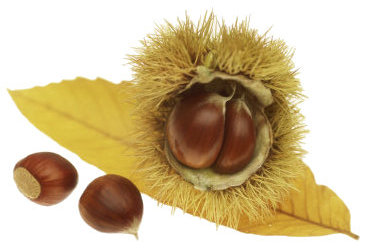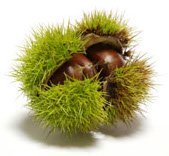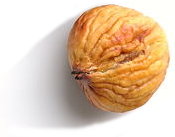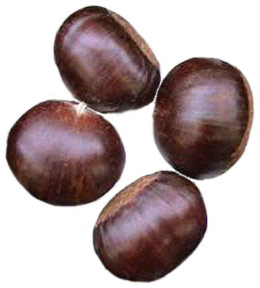

Sweet Chestnuts

Castanea. (from Latin castanea, chestnut.) CHESTNUT; CHINKAPIN. Fagaceae. About 12 species of deciduous, monoecious trees and shrubs to 40m. Bark grey to black, furrowed. Shoots stout, green soon becoming purple-brown to grey-brown; stipules 1cm, early deciduous in early summer; buds ovoid, bud scales few, rounded, terminal bud absent. Leaves alternate, usually conspicuously toothed, oblong-lanceolate or narrow-oval, with numerous parallel veins angled outwards from midrib, indented above and raised beneath, subglabrous to densely downy, colouring gold in autumn. Flowers muskily scented, in long slender catkins from leaf axile of young shoots in midsummer; lower catkins entirely male, stamens 10-20; in axils of later leaves grow shorter catkins, bases of which bear 1-5 female flowers, each with 4-9 styles; apex often also with some fertile or more commonly sterile male flowers; both male and female flowers with 6-parted pale yellow calyx, corolla lacking. Fruit in clusters of 1-5; casing a globose, 4-8cm involucre or ‘burr’, covered with branched spines, splitting open in four sections; nuts 1-7 (mostly 1-4), variable, 1.5-3.5cm, ovoid-acute, section obtuse-triangular or elliptic, depending on position in burr, glossy chestnut-brown with a large pale basal scar. Warm temperate regions of Eastern N America and S Europe east to China and Japan. CultivationChestnuts are attractive drought-tolerant trees grown for their large bright green leaves, yellow-brown autumn colour, for the nuts, eaten roasted or candied (marrons glacé) and timber. Only Castanea sativa is fully adapted to cool summers, most other species, with the possible exception of Castanea crenata, thrive only with high summer temperatures. All would grow well in E US (N to Maine), where the native Castanea dentata is now replaced in cultivation by blight-resistant though smaller-growing Chinese Castanea mollissima and Japanese Castanea crenata in cultivation. Castanea dentata still occurs as suckering stands, reduced by chestnut blight; sometimes regenerating stems may reach fruiting size - this suggests that some progress is being made toward resistance. The US Forest Service and Dr R.A. Joyner at the Conneticut Agricultural Experimental Station have produced hybrids of Castanea dentata with the blight-resistant Castanea mollissima and the less susceptible Castanea crenata. For nut production, selection depends mainly on nut size; this is often related to the ability of the tree to suppress all but one large nut in each burr. Individual trees are largely self-fertile, and two or more clones should be planted together to ensure a good seed set. Castanea mollissima and derivatives are the best fruiting alternative to Castanea dentata and Castanea sativa. Grow in well-drained slightly acid deep loams; most species are very tolerant of highly acid infertile dry sands, especially the mostly shrubby American chinakpins and Castanea sativa, and make excellent soil-enriching understorey in pine forest. They do not grow well on chalk but will tolerate harder limestones. Propagation as for Quercus; cultivars are grafted on seedlings of Castanea sativa or Castanea crenata. Most can hybridise freely; seed should be from extensive single-species stands or wild-collected if specific identity is to be guaranteed. The only serious disease is chestnut blight, Cryphonectria parasitica (synonoymous with Endothia parasitica); this has virtually wiped out the highly susceptible Castanea dentata, killing trees to ground-level by blocking the vessels with its mycelia. The disease was accidentally introduced to the US around 1904, probably on plants imported from Asia; by 1940 no mature specimens affected survived. The roots can transmit the disease through root grafts, but are often not killed, sending up coppice growth which can reach 10m or so before reinfection cuts them to the ground again; this alone has prevented the species’ extinction. The sprores are spread, often for long distances, by wind and birds. Castanea sativa is susceptible, but less so than Castanea dentata; heavy losses have occurred in S Europe as well as N America, but the disease appears unable to tolerate the cooler summers of N Europe and has not spread to Britain despite its powers of long-range dispersal. the Asian species, and some of their hybrids with Castanea dentata, are resistant. Dieback fungus can kill twigs and cause bark cankers. 
Fruit can be infested by chestnut weevils (Curculonidae). They lay their eggs on the developing fruit in summer: the larvae bore into the burr and feed on the kernel as it grows. The weevil pupates in the soil beneath the trees and may be dealt with most easily at this stage. They are a serious problem in nut orchards where control by spraying is difficult due to the size of the trees, but of little significance in the garden. The two-lined chestnut borer is a threat to small or weak trees, tunneling under the bark, sometimes to the extent of ring-barking the tree. The beetles should be controlled in summer when active. The nuts are also extensively eaten by woodpigeons, jays, squirrels, and others. Castanea crenataJAPANESE CHESTNUT. Spreading, short-trunked tree to 20m, often less. Young shoots scaly to densely downy. Leaves 7-18 x 3-5cm, oblong glabrous above, grey downy beneath, base rounded or cordate, apex short-pointed, margin crenate to serrate, teeth numerous small aristate; petiole 1-1.5cm. Fruit a globose burr with dense slender spines, 4-8cm diameter, nuts 1-4, 2-3cm, to 3.5-4cm on selected clones. Japan. Castanea crenata has been crossed with Castanea dentata, producing ‘Essate-Jap’ and ‘Sleeping Giant’, an excellent timber tree with blight resistance. Z4. Castanea dentataAMERICAN SWEET CHESTNUT. Tree to 45m with trunk to 4m diameter, or a coppice to 5-10m having survived chestnut blight. Young shoots glabrous or slightly scurfy at first. Leaves 14-22 x 4-5cm, dull green, glabrous above and beneath, oblong-lanceolate, cuneate, apex acuminate, margins with large, glandular teeth; petiole 1cm. Male catkins 10-20cm. Fruit now rarely seen, clustered 1-3, a globose burr 5-7cm diameter, with dense slender spines; nuts 2-3.5cm. mostly 2-3 in a burr. E US (Maine to Alabama). Z4. Castanea mollissimaCHINESE CHESTNUT. Broad-crowned, stout-trunked tree to 20m. Young shoots thinly or velvety hairy. Leaves 12-22 x 5-9cm, glabrous above, tomentose at least on veins to almost glabrous beneath, varying even between leaves of one tree, broadly oblong-lanceolate to elliptic, apex acuminate, margin with triangular or aristate teeth; petiole short,1cm. Male catkins 10-20cm. Fruit clustered 1-4, yellow-green burr 5-8cm with dense slender spines, nuts 1-4, 2-3cm, to 3.5-4cm on selected clones. Exact range uncertain due to extensive cultivation; wild or naturalised in Korea and most of China from Beijing to Yunnan. Z4. Large-fruited selcections of Castanea mollissima include ‘Nanking’, ‘Meiling’, ‘Kuling’ and ‘Kelsey’, a small tree with small sweet fruit. Castanea sativa
SWEET CHESTNUT; SPANISH CHESTNUT.Tree to 40m, trunk to 4m diameter. Young shoots initially pubescent, soon glabrous. Leaves 12-25 x 4-10cm, minutely glandular above at first, soon glabrous, thinly pubescent beneath, becoming glabrous through summer; oblong-lanceolate, base rounded to slightly cordate, apex acute to acuminate, margin with aristate teeth spaced 1cm apart, 15-25 pairs of veins; petiole 1.5-2.5cm. Male catikins 15-30cm; female catkins 4-6cm or to 12cm with sterile male flowers at apex. Fruit clusterd 1-5, yellow-green burr 4-7cm, with dense, slender spines; nuts 1-5(-7) in each burr, mostly 2-3cm. Exact range uncertain due to extensive cultivation for over 3000 years; wild or naturalised throughout S Europe, NW Africa and SW Asia from Iberia and Morocco to Pakistan; probably native only from Balkans east to N Iran. Numerous cultivars; selected for large nuts (‘Marron de Lyon’, ‘Gros Merle’, ‘Paragon’; nuts often solitary, to 3.5-4cm); for leaf-form, including cut-leaved (‘Aspendifolia’, ‘Laciniata’; leaves to rarely 45 x 1cm), variegated (‘Albomarginata’), purple (‘Purpurea’) and polymorphic, linear to oblong, sometimes incised (‘Heterophylla’); and crown form (‘Holtii’; crown narrowly conic). Z5. Other species of the genus Castanea are not included here because they are not cultivated for their sweet edible nuts.
|
Home
Grow Herbs
Grow Fruit
Grow Vegetables
Cyberian Index
If you like this website and want one of your own contact
Cyberian All information correct at
time of publication and open to updates as necessary. No part of this website,
or its vectors, may be produced in any shape or form, using any type or design
of medium, system, equipment or otherwise without the prior written consensual
notice of the Cyberian. Any breach of these requirements will result in the
appropriate action. If in doubt, e-mail contact is recommended.
Some components of this website were obtained as open-source software and are
used in the same non-profit manner on this website.